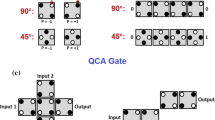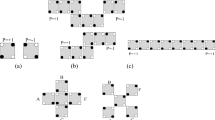Emerging technologies have been widely advocated to supersede the projected limitations of CMOS at the end of the roadmap [27]. Computation at nano regimes is substantially different from conventional VLSI. Extremely small feature size, high device density and low power are some of the attributes that emerging technologies must address, while implementing new computational paradigms [1]. One of these paradigm is reversible computing. Reversible computation is accomplished by establishing a one-to-one onto mapping between the input states and output states of the circuit [7]. This bijective property was initially investigated by Landauer who showed that kT ln 2 joules of energy are generated for each bit of information lost due to non reversible computation [6]. But,if computation is performed in a reversible manner, it has been shown that kT In 2 energy dissipation would not necessarily occur. Due to the bijective property, testing of reversible logic is generally simpler than conventional irreversible logic [31].
Access this chapter
Tax calculation will be finalised at checkout
Purchases are for personal use only
Preview
Unable to display preview. Download preview PDF.
Similar content being viewed by others
References
S. Muroga, “Threshold Logic and its Applications”, Wiley Interscience, New York, 1971.
T. Toffoli, “Reversible Computing”, Technical Report MIT LCSTM151, MIT Laboratory for Computer Science, 1980.
E. Fredkin and T. Toffoli, “Conservative Logic”, International Journal of Theoretical Physics, vol. 21, pp. 219-253, 1982.
C.H. Bennett, “Logic Reversibilty of Computation”, IBM Journal of Research and Development, vol. 17, pp. 525-532, 1973.
D. Maslov, G.W. Dueck and D.M. Miller, “Synthesis of Fredkin-Toffoli Reversible Networks”, IEEE Transaction on VLSI, 2004.
R. Landauer, “Irreversibility and Heat Generation in the Computing Process”, IBM Journal of Research and Development, vol. 5, pp. 183-191, 1961.
M. Nielsen and I. Chuang, “Quantum Computation and Quantum Information”, Cambridge University Press, Cambridge, 2000.
W. Wang, R. Zhang, K. Walus and G.A. Jullien, “A Method of Majority Logic Reduction for Quantum Cellular Automata”, IEEE Transaction on Nanotechnology, vol. 3(4), pp. 443-450, 2004.
C.S. Lent, P.D. Tougaw and W. Porod, “Quantum Cellular Automata: The Physics of Computing with Arrays of Quantum Dot Molecules”, Proceedings of the Workshop on Physics and Computing, pp. 5-13, 1994.
M.T. Niemier and P.M. Kogge, “Problems in designing with QCAs: lay- out=timing”, International Journal of Circuit Theory and Applications, vol. 29(1), pp. 49-62, 2001.
M.T. Niemier and P.M. Kogge, “Logic-in-Wire: Using Quantum Dots to Imple- ment a Microprocessor”, International Conference on Electronics, Circuits, and Systems (ICECS ’99), vol. 3, pp. 1211-1215, 1999.
K. Hennessy and C.S. Lent, “Clocking of Molecular Quantum-Dot Cellular Au- tomata”, Journal of Vaccum Science and Technology, vol. 19(5), pp. 1752-1755, 2001.
I. Amlani, A.O. Orlov, G. Toth, C.S. Lent, G.H. Bernstein and G.L. Snider, “Digital Logic Gate Using Quantum-Dot Cellular Automat”, Science, vol. 284(5412), pp. 289-291, 1999.
S.E. Frost, A.F. Rodrigues, A.W. Janiszewski, R.T. Rausch and P.M. Kogge, “Memory in Motion: A Study of Storage Structures in QCA”, 1st Workshop on Non-Silicon Computation, 2002.
M.T. Niemier, A.F. Rodrigues and P.M. Kogge, “A Potentially Implementable FPGA for Quantum Dot Cellular Automata”, 1st Workshop on Non-Silicon Computation (NSC-1), held in conjunction with 8th Int. Symp. on High Performance Computer Architecture (HPCA-8), 2002.
P.D. Tougaw and C.S. Lent, “Logical Devices Implemented Using Quantum Cellular Automata”, Journal of Applied Physics, vol. 75(3), pp. 1818-1825, 1994.
V.S. Dimitrov, G.A. Jullien and K. Walus, “Quantum-Dot Cellular Automata Carry-Look-Ahead Adder and Barrel Shifter”, IEEE Emerging Telecommunications Technologies Conference, pp. 2/1-2/4, 2002.
C.G. Smith, “Computation Without Current”, Science, vol. 284(2), p. 274, 1999.
K. Walus, R.A. Budiman and G.A. Jullien, “Effects of morphological variations of self-assembled nanostructures on quantum-dot cellular automata (QCA) circuits”, Frontiers of Integration, An International Workshop on Integrating Nanotechnologies, 2002.
K. Walus, A. Vetteth, G.A. Jullien and V.S. Dimitrov, “RAM Design Using Quantum-Dot Cellular Automata”, NanoTechnology Conference, vol. 2, pp. 160-163, 2003.
M.B. Tahoori, M. Momenzadeh, J. Huang and F. Lombardi, “Testing of Quna- tum Cellular Automata”, IEEE Transaction on Nanotechnology, vol. 3(4), pp. 432-442, 2004.
J. Huang, M. Momenzadeh, M.B. Tahoori and F. Lombardi, “Defect Characterization for Scaling of QCA Devices”, Proceedings of the IEEE International Symposium on Defect and Fault Tolerance in VLSI Systems, pp. 30-38, 2004.
D.A. Antonelli, D.Z. Chen, T.J. Dysart, X.S. Hu, A.B. Kahng, P.M. Kogge, R.C. Murphy and M.T. Niemier, “Quantum-Dot Cellular Automata (QCA) Circuit Partitioning: Problem Modeling and Solutions”, Design Automation Conference (DAC), pp. 363-368, 2004.
K. Walus, G.A. Jullien and V.S. Dimitrov, “Computer arithmetic Structures for Quantum Cellular Automata”, Proceedings of Asimolar Conference, 2003.
J. Huang, M. Momenzadeh, M. Ottavi, L. Schiano and F. Lombardi, “A Predeposition Methodology for Tile-Based Design of QCA Combinational Circuits”, Internal report, 2004.
M. Momenzadeh, J. Huang, M. Ottavi, N. Park and F. Lombardi, “Computing with Grids of QCA Cells”, Internal report, 2004.
R. Compano, L. Molenkamp and D.J. Paul, “Technology Roadmap for Nanoelectroincs”, European Commission IST programme, Future and Emerging Technologies, 2000.
Reversible Logic Synthesis Benchmarks Page, available online: http://www.cs. uvic.ca/damslov
Personal communication with Professor Marya Lieberman, Department of Chemistry and Biochemistry, University of Notre Dame, IN, USA.
V.D. Agrawal, “An Information Theoretic Approach to Digital Fault Testing”, IEEE Transaction on Computers, vol. 30, pp. 582-587, 1981.
K.N. Patel, J.P. Hayes and I.L. Markov, “Fault Testing for Reversible Circuits”, IEEE Transaction on CAD, vol. 23(8), pp. 1220-1230, 2004.
J. Timer and C.S. Lent, “Maxwell’s Demon and Quantum-dot Cellular Automata”, Journal of Applied Physics, vol. 94(2), pp. 1050-1060, 2003.
M. Liu, C.S. Lent, “Bennett and Landauer Clocking in Quantum-dot Cellular Automata”, International Workshop on Computational Electronics, Abstracts pp. 120-121, 2004.
T.H. Cormen, C.E. Leiserson, R.L. Rivest and C. Stein, “Introduction to Algorithms, 2nd ed.”, McGraw-Hill, New York, 2001.
A. Chakraborty, “Synthesis of Reversible Circuits for Testing with Universal Test Set and C-Testability of Reversible Iterative Logic Arrays”, Proceedings of the 18th International Conference on VLSI Design, 2005.
QCADesigner Homepage, available online: www.qcadesigner.ca
Author information
Authors and Affiliations
Editor information
Editors and Affiliations
Rights and permissions
Copyright information
© 2008 Springer Science+Business Media, LLC
About this chapter
Cite this chapter
Ma, X., Huang, J., Metra, C., Lombardi, F. (2008). Reversible and Testable Circuits for Molecular QCA Design. In: Tehranipoor, M. (eds) Emerging Nanotechnologies. Frontiers in Electronic Testing, vol 37. Springer, Boston, MA. https://doi.org/10.1007/978-0-387-74747-7_6
Download citation
DOI: https://doi.org/10.1007/978-0-387-74747-7_6
Publisher Name: Springer, Boston, MA
Print ISBN: 978-0-387-74746-0
Online ISBN: 978-0-387-74747-7
eBook Packages: EngineeringEngineering (R0)




